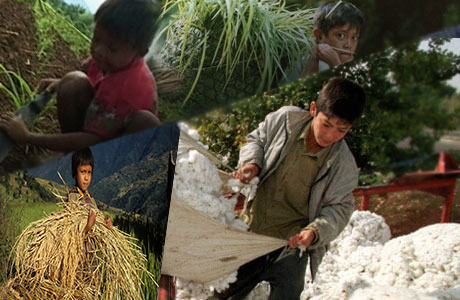Child Labour in Cotton Growing Districts Of Pakistan
By: Meena Gabeena
 Pakistan is a large producer of cotton in the world. Globally, Pakistan produces 9% of the total global cotton production and is considered the fourth largest producer of cotton in the world and the third largest global consumer.
Pakistan is a large producer of cotton in the world. Globally, Pakistan produces 9% of the total global cotton production and is considered the fourth largest producer of cotton in the world and the third largest global consumer.
However, despite enjoying this status, Pakistan ranks among the top ten countries producing cotton by using forced child labour.
Regrettably for decades now, children as young as 10 have been forced to pick cotton under appalling condition each harvest season. Children, particularly girls, usually work whole day during the sowing and picking seasons.
These children and their families are exposed to pesticides causing life-threatening harms to their lives. In addition to that, the primary healthcare services are insufficient and unattainable.
The education system either excludes many children or offer poor quality education in a highly unprotected environment.
As per a recent survey conducted by Save the Children in two cotton growing districts i.e., Lodhran in Punjab and Shaheed Benazir Abad in Sindh, Child labour prevalence rate in ShaheedBenazirabad is 50% and in Lodhran is 43%.
While the findings show that in Benazirabad 71.4% and in Lodhran 68% of 5-17 years of age children are engaged in the agriculture sector, including cotton sector. 22%, which is a significant number of households in Shaheed Benazir Abad, and 16% in Lodhran reported that children suffer harassment and physical punishment at work.
The actual numbers may be higher, as there is general consensus amongst experts that this significant proportion remains unreported. The poor state of child rights in the two districts remains similar to rights violations in most other rural areas in Pakistan.
A large proportion of children are denied their fundamental rights to survival, development, protection and participation and they can therefore, if addressed in a structured way together with learning from model work already initiated by some NGOs, pave way for building contextual appropriate systems to protect children and have a long-lasting impact.
The Main Reason For Forcing Children To Work
The main reason for forcing children to work is poverty which pushes families to send children to work in hazardous conditions in addition to a mix of non-child friendly socio-cultural values, structural inequalities, inadequately resourced and incomplete public child protection systems putting children at risk to abuse, violence, exploitation and neglect.
There is also Poor quality, access and non-inclusive basic education, leading to non-attendance, dropouts and in turn fuelling child labour. The lack of knowledge is of grave concern besides the lack of access to and availability of skilled work force for quality healthcare.
Pakistan is seriously deficient in targets for almost all Millennium Development Goals. An estimated 12 million children are working in Pakistan, out of which 5 million children are engaged in hazardous forms of labour and 1.7 million children are enslaved in bonded labour.
The responsible government must work for protection of rights of children working in the cotton farming areas or are at risk of being engaged in child labour.
There should be a strategy based on empowerment of communities, with special focus on engaging and empowering mothers.
There is a dire need of creating and strengthening child protection mechanisms at the community, districts and provincial level in order to increase access of children to school.
Quality of education must also be improved with an addition of promoting health education for protection from hazards from working in cotton fields and promoting mother child health in cotton communities through strengthening existing health care and education systems.
A program like Benazir Income Support program has already successfully focused on economic empowerment of mothers, similar fruitful initiatives could be taken for adolescent girls and boys for them to support the family income, which can lead to withdrawal of children from work.
The United Nations Convention on the Rights of the Child (UNCRC) was ratified in 1989 by 192 states, where Pakistan ratified it in 1990. The UNCRC has helped protect children worldwide for the last 20 years.
In Pakistan, however a breakthrough in the protection of child rights can only be reached if two national child protection bills tabled in parliament in 2009 are enacted into law.
The Charter of Child Rights Bill which commits the federal government to take all appropriate legislative, administrative, social and educational measures to protect children and the Protection of Children Bill which makes sexual abuse of children, corporal punishment and child marriage offences punishable by imprisonment and/or fines.
The Protection of Children Bill also provides for the setting up of a network of child protection institutions.
The sooner we turn these two bills into law, the quicker would resources be routed into protecting our children from labour and abuse.
October, 2014
Source: Daily Times